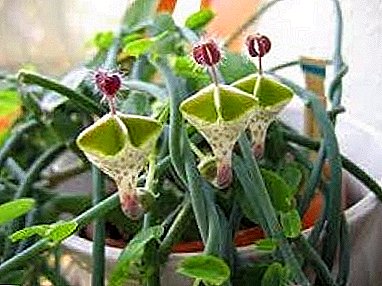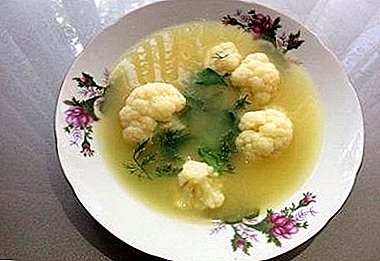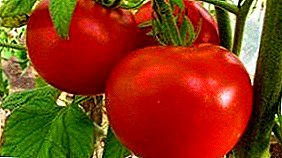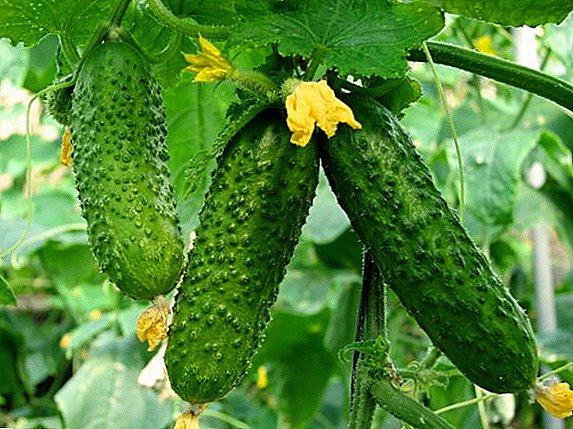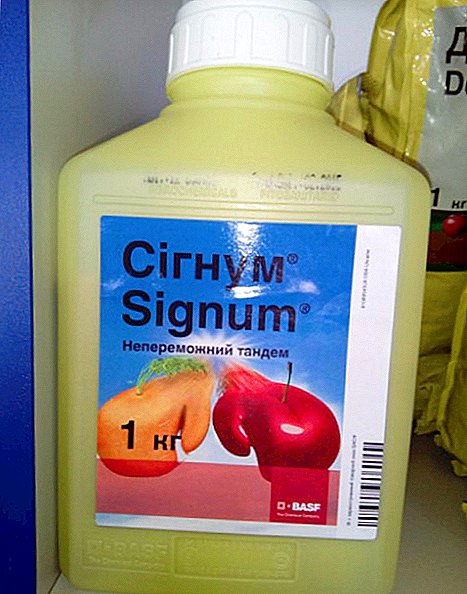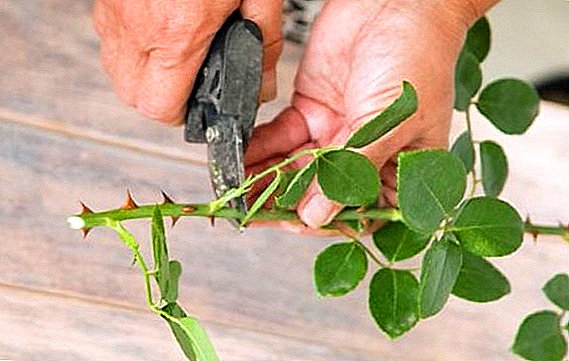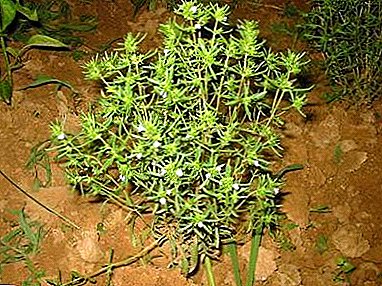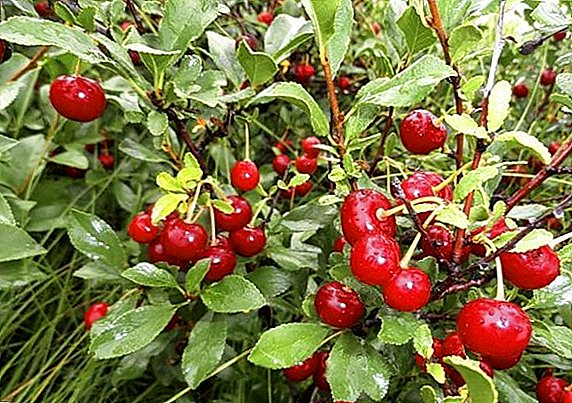 Steppe cherry is common in the countries of the former USSR, especially in Russia.
Steppe cherry is common in the countries of the former USSR, especially in Russia.
It is popular for breeding, as well tolerates high and low temperatures.
In this article we will consider all the features of its cultivation.
Description of the bush
Steppe cherry grows in the form of a shrub and reaches a height of no more than 2 m. On straight or slightly descended branches of green or brown color, small green leaves of elongated shape, up to 8 cm long, are located on short petioles 1.5 cm each. the ball is flattened, its diameter is about 1 m.
Did you know? Cherries came to the territory of Europe 2 thousand years ago from China and the Caucasus.
 White small flowers grow alone or in inflorescences, bloom in the spring before the leaves grow back, in the middle up to 15 stamens are located, abundant bloom. This variety requires cross-pollination, so you need to plant a few cherries.
White small flowers grow alone or in inflorescences, bloom in the spring before the leaves grow back, in the middle up to 15 stamens are located, abundant bloom. This variety requires cross-pollination, so you need to plant a few cherries.The root system is well developed, the roots are long, 1.5 m deep, and 8 m wide, about 0.5 m located on the surface.
Fruit Description
Fruits the tree generously edible fruits from pink to dark red, no more than 3 cm in diameter. Fruits are spherical, sometimes slightly elongated, covered with a non-rigid skin, weigh about 3 g each, grow on thin stalks.  The flesh of the fruit is juicy, the taste is sour-sweet, inside there is a light rounded bone about 5 mm in size. From the fruit is boiled jam, jam, compote, eaten fresh.
The flesh of the fruit is juicy, the taste is sour-sweet, inside there is a light rounded bone about 5 mm in size. From the fruit is boiled jam, jam, compote, eaten fresh.
Find out which cherry varieties are the largest.
The main characteristics of the form
Those who have already planted such a sort of cherry, note its resistance to adverse temperature conditions and the ability to produce a rich harvest.
Winter hardiness
The shrub calmly tolerates frost down to -50 ° C. Although its root system may suffer during severe frosts, it recovers quickly. Survive frosts and swollen buds are able to cherry. 
Important! Cherry steppe is the most resistant to frost of all fruit-bearing plants.
Drought tolerance
Due to the deep growth of the roots, this variety of cherry tolerates a dry period with a decrease in humidity up to 20% and air temperature above +40 ° C.
Fruiting and Yield
For the first time, steppe cherry begins to bear fruit on the 4th-5th year after planting, the fruits continue to ripen for 35 years. Maturation occurs at the end of July. One bush can produce up to 11 kg of berries per season, and from 1 hectare it is possible to collect over 10 tons of cherries.
The most popular varieties of steppe cherries
The most popular varieties of steppe cherries are:
- "Bolotovskaya" - fruits ripen late, large, have a dark color. Suitable for arid and frosty zones, lush crown. Young bushes bear fruit from the 3rd year of life. Do not need cross pollination.
- "Desired" - fruits are red, medium size, ripen in mid-summer, blooms early, leaves have sharp tips, lowered branches, tolerates frost and drought well.
- "Generous" - tall bush, well fructifies for 32 years, dark-colored fruits, medium-sized, sweet, ripen at the end of summer, resistant to frost and drought.
- "Altai swallow" - srednerosly bush, needs annual pruning, resistant to severe frosts, needs cross-pollination, the fruits are sweet, ripen in mid-summer, stored poorly.
- "Ashinskaya" - high, with large fruits and a rich harvest, after planting begins to bear fruit from 4 years, suitable for arid zones and regions with medium frosts, almost not affected by fungi.
- "Maksimovskaya" - large red fruits ripen in mid-summer, slightly oval, triangular crown, few trunks, resistant to frost and drought.
- "Irtysh" - it has a special winter hardiness, but it does not tolerate drought badly, needs cross-pollination, the fruit is tasteless, more suitable for preservation than for fresh consumption.
- "Subbotinsky" - tall bush up to 2.5 m in height with a dense crown, often affected by fungus and needs regular pruning, gives large sweet fruits, resistance to drought and frost is medium.



Growing conditions
In order for the steppe cherry to bear fruit well and for a long time, it is necessary to choose the right place for its planting. It must be well lit, without drafts, not lowland, so that water does not stand there.
The bush is not too picky about the ground, but it will be better if you plant it in a non-acidic, loose, sand-rich soil.
Learn what soil acidity means for garden and garden crops and how to determine the acidity of the soil on the plot yourself.
Given that most varieties need cross-pollination, take care of the presence of a few more cherries.
Optimum time and recommended landing pattern
 The best time to plant a steppe cherry is the beginning of April, when the snow had already melted. The soil is first dug up to a depth of 20 cm and fertilized with compost, manure, phosphate or potash fertilizers.
The best time to plant a steppe cherry is the beginning of April, when the snow had already melted. The soil is first dug up to a depth of 20 cm and fertilized with compost, manure, phosphate or potash fertilizers.
2 weeks before planting, dig holes in the size corresponding to the volume of the roots in the straightened state, taking into account a drainage layer of 10 cm. The distance between them should not be less than 1.5 m. Sand and peat are poured at the bottom of the hole. After planting, seedlings are watered abundantly and powdered with ashes.
Did you know? In the United States there is the National Day of Cherry Pie, which is celebrated on February 20 (February is the national month of cherries). On this day, it is customary to eat cherry pies and treat friends to them.
Highlights in the care
Steppe cherry is not demanding to care, but without it, the harvest will not be so rich, and the life of the bush can be reduced.
Watering
To prevent the roots from rotting, they water adult cherries 3 times:
- When bloom.
- When the fruit is tied.
- When the fruits ripen.
Top dressing
Fertilize shrubs better in spring and autumn, when it is at rest. However, some gardeners recommend fertilizing after flowering. Organic, humus, ash, phosphate, potash, and nitrogen fertilizers are suitable for fertilizing.
Soil care
The land around the shrub should be regularly loosened, free from weeds, not allowing them to take away the nutrients.
To keep the soil friable longer, and the weeds to grow worse, it is recommended to mulch with natural materials - dry leaves, sawdust, mowed grass, etc.
Pruning and shrub formation
 The correct pruning of the crown is a guarantee of a good harvest, because there will be no harvest on the affected branches and young shoots. Pruning is carried out annually, starting with the first year of the bush life.
The correct pruning of the crown is a guarantee of a good harvest, because there will be no harvest on the affected branches and young shoots. Pruning is carried out annually, starting with the first year of the bush life.
The basic rules for pruning and forming a bush:
- In autumn and early spring, dried and affected shoots should be cut.
- To ensure the growth of side branches, cut off the tip of the bush.
- From the bottom they leave 5 thick branches, located not less than 3 cm apart.
- Small branches that form a dense crown, need to thin out, otherwise they will cast a shadow and will not allow to get a good harvest.
- Old branches are removed no earlier than 8 years.
Important! When trimming a bush, take into account that steppe cherries bear only shoots that grew in the past year.
Advantages and disadvantages
The advantages of growing steppe cherries:
- Resistance to frost and drought.
- No need for careful care of shrubs.
- Groundiness.
- A bountiful harvest.
- Delicious fruits.
- Long term life.
- Ease of breeding and reproduction.
- Ability to use for decorating the site.
Negative aspects of growing plants:
- Fruits ripen late and poorly stored.
- The shrub begins to give fruit no earlier than 4 years after planting.
- The crown should be regularly cut.
- Can not stand the shadow.
- Needs cross pollination.
- Affected by pests, coccomycosis and nodules.
It will be interesting for gardeners who grow cherries on their plot to learn how the cherry is useful, how to prepare its fruits for the winter and how to make tea from the leaves of the cherry.
Thus, having planted a steppe cherry on a plot, you not only ennoble it, but you can regularly receive a rich harvest. An important advantage is undemanding plants and the possibility of growing in frosty and arid regions. However, do not forget to prune the shrub and treat it from pests and diseases.


